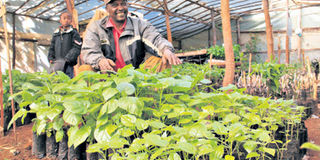Show me a fruit seedling and I will graft it for you

David Murigi in his farm at Giakanja, Nyeri County, where he grows seedlings and fruits. PHOTO | JOSEPH KANYI
What you need to know:
- The farmer witnessed a bumper harvest, which he sold for Sh1.50 per fruit in Nyeri.
- Maina Karuiru, a consultant at Food Quality and Safety Services Company, says grafting of seedlings helps to better the plant and produce.
The process, according to him, improves the make-up of trees thus increasing the yields and quality of fruits.
Whenever he sees a plant, what comes to David Murigi’s mind is whether he can graft it.
Murigi loves the art and has been using it for many years to grow seedlings of various fruits, which he sells to farmers.
“I love grafting. It gives the best when it comes to avocados and other fruits,” says the farmer, who is based in Giakanja, Nyeri.
The former mechanic in the Ministry of Roads and Public Works has a well-kept 0.9 acre farm where he grows the seedlings.
“I learned the craft from Wambugu Farm in Nyeri, where I used to visit before I was retrenched in 2000 and ventured into fruit farming. I highly admired the grafting processes, which add value to fruits.”
He has grafted over 10,000 seedlings ever since he started.
“My first tree to graft was the avocado Fuerte variety. I acquired it from a foreigner in Subukia. This is what I began with when I decided to start farming.”
The farmer witnessed a bumper harvest, which he sold for Sh1.50 per fruit in Nyeri.
“The Fuerte variety fetch as low as Sh1.50 a fruit due to its quality. They are very shiny and bigger than the Giant variety but go stale fast,” he says.
He adds that the Golden avocado variety fetches better prices of about Sh5 in the export market.
“Due to the difficulties in marketing the fruits, I decided to produce seedlings for other farmers to purchase,” says Murigi, who went into seedlings farming four years ago.
He used his Sh80,000 savings to construct a 70 by 35 metres greenhouse.
“I realised that seedling farming in a greenhouse is better than planting in the open air nursery,” he explains.
Grafting starts with identifying the two plants to undergo the procedure.
The scion is cut into six-inch strips and tied in bundles.
“Put the branches in water to ensure they do not dry. One should cut the branch at the crotch, just above where the smaller branches begin growing before grafting,” he says.
“When ready for grafting, carefully insert the scion into the bark and secure it with a tape. It will be ready after three to six weeks, or until the new graft begins to bud.”
For oranges, one should cut a bud where it appears then insert on the bark of a lemon tree for seedless oranges.
“One can graft basically any tree seedling. I even graft Irish potatoes with tomatoes and after every three months I harvest tomatoes and potatoes from the same plant.Apart from the Hass variety avocados, I have about 100 grafted apples from the 500 that I just sold for Sh550 a seedling,” he says. Most of the time Murigi works until late into the night grafting the seedlings. “Last night I grafted avocado tree seedlings up to 2am. I am struggling to meet an order of 500 seedlings from a client.”
Seedlings of Hass avocado variety sell for Sh200. A grafted apple tree seedling fetches him Sh550 while a grape goes for Sh200.
Grafted custard apple variety, which produce bigger fruits than the South African variety can produce over 600 fruits.
“An apple bud can produce about 10 fruits,” says the 56-year-old father of five.
Grafted orange, tangerine and mango “dodo” seedlings cost between Sh100 and Sh150 respectively. Other grafted seedlings, including strawberry, tomato, paw paw, giant and sweet yellow passion fruits cost Sh60 each.
“No venture can succeed without hard-work and dedication. I attend to five to 10 customers in a busy week. In about two months, I pocket Sh200,000 and above. I love what I do.”
Maina Karuiru, a consultant at Food Quality and Safety Services Company, says grafting of seedlings helps to better the plant and produce.
The process, according to him, improves the make-up of trees thus increasing the yields and quality of fruits.
The process, he adds, gives a farmer options as one can get the variety and quality of fruits they want.
“Grafted mangoes take a shorter period to produce fruits than ordinary ones.
The practice is highly-recommended because farmers do not have to wait any longer for their fruits to mature. They will then be of higher quality thus fetch more money.”
He advises that anyone who wants to go into grafting of fruits must seek expert advice.
“An expert would advise one on what to grow, how to do it and opportunities and challenges. Grafting can be very complicated if one does not know what to do.”





